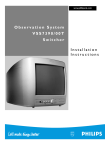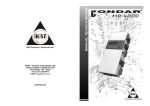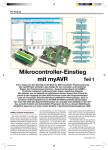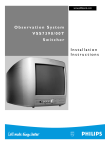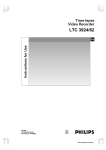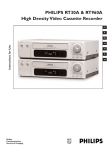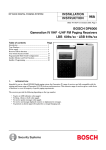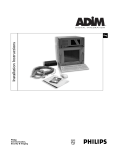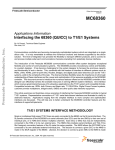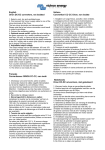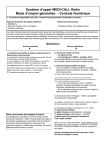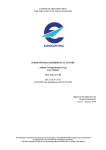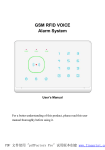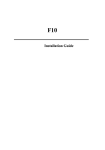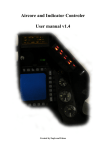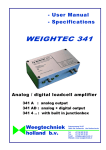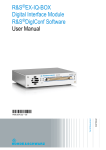Download High Performance Paging Transmitters LBB 5888 VHF 0.5 – 5 W
Transcript
Installation Instructions 85 High Performance Paging Transmitters LBB 5888 VHF 0.5 – 5 W LBB 5868 UHF 0.5 – 5 W LBB 6019 UHF 50 mW Philips Communication, Security & Imaging 9922 141 50041 en April 2002 © 2002 Philips Electronics N.V. Data subject to change without notice INSTALLATION INSTRUCTIONS 85 DP6000 DIGITAL PAGING SYSTEM VHF/UHF TRANSMITTERS TABLE OF CONTENTS 1 Introduction ....................................................................................................................................................... 4 1.1 Purpose of this manual............................................................................................................................................................... 4 1.2 Intended audience of this manual ............................................................................................................................................ 4 1.3 Available documentation ........................................................................................................................................................... 4 1.4 CE marking .................................................................................................................................................................................. 4 1.5 Declaration of Conformity ........................................................................................................................................................ 4 1.6 Transmission licence................................................................................................................................................................... 5 1.7 Modifications ............................................................................................................................................................................... 5 1.8 ESD protection............................................................................................................................................................................ 5 1.9 Contact addresses........................................................................................................................................................................ 5 1.10 Contents of the packing............................................................................................................................................................. 6 1.11 Abbreviations............................................................................................................................................................................... 6 2 Product overview................................................................................................................................................ 7 3 Wall mounting.................................................................................................................................................... 9 4 Power supply...................................................................................................................................................... 9 4.1 Power supply from the mains ................................................................................................................................................... 9 4.2 12 Vdc power supply output..................................................................................................................................................... 9 5 External connections ........................................................................................................................................ 10 5.1 Power input ................................................................................................................................................................................ 10 5.2 DP6000 bus................................................................................................................................................................................ 10 5.3 RF synchronisation input......................................................................................................................................................... 11 5.4 RF antenna output .................................................................................................................................................................... 11 6 PCB Layouts ..................................................................................................................................................... 12 7 LED indicators ................................................................................................................................................. 15 8 Jumpers ............................................................................................................................................................. 15 9 Adjustments ...................................................................................................................................................... 16 9.1 Factory settings.......................................................................................................................................................................... 16 9.2 Output power adjustment........................................................................................................................................................ 16 9.3 Frequency deviation adjustment............................................................................................................................................. 16 10 Synchronisation................................................................................................................................................. 17 10.1 LF synchronisation ................................................................................................................................................................... 17 10.2 Settings for LF synchronisation.............................................................................................................................................. 18 10.3 RF synchronisation ................................................................................................................................................................... 19 10.4 Settings for RF synchronisation ............................................................................................................................................. 19 9922 141 50041 en April 2002 Page 3 of 22 INSTALLATION INSTRUCTIONS 85 1 DP6000 DIGITAL PAGING SYSTEM VHF/UHF TRANSMITTERS INTRODUCTION 1.1 Purpose of this manual This manual supplies an engineer with the information required to install and replace the UHF/VHF transmitters. The complete technical specifications can be found in the Data Sheets. Refer to the Service Manual for maintenance, troubleshooting and repair. 1.2 Intended audience of this manual This manual has been written with the service engineer in mind. However, this does not mean that there are no other legitimate users of this manual. To be able to make the right judgements in error situations, such a person must have had an education on engineering level and must have had training on general DP6000 paging system tasks. Great care has been taken to ensure that the information in this manual is complete and correct. However, maintenance and repair of sophisticated electronic equipment is a task for trained engineers, well aware of the dangers and risks involved. 1.3 Available documentation The following documentation is available for the UHF/VHF transmitters: 12 NC Name 9922 141 50021 9922 141 50031 9922 141 50041 3922 880 00811 Datasheet LBB 5888 and LBB 5868 Datasheet LBB 6019 Installation Instructions (this manual) Service Manual 1.4 CE marking This product has the CE marking consulted Notified Body. 0344 . The number added to the CE mark is the identification number of the This transmitter is using frequencies which are not harmonised in the European Community. 1.5 en Declaration of Conformity Philips Communication Security & Imaging declares that the transmitters LBB 5888 (VHF 0.5-5W), LBB 5868 (UHF 0.5-5W) and LBB 6019 (UHF 50 mW) are in conformance with the essential requirements of the R&TTE Directive 1999/5/EC. The official Declaration of Conformity can be found on the Philips CSI Extranet. All Philips National Sales Organisations and authorised dealers have access to the Philips CSI Extranet. Please contact one of those if necessary. fr Philips Communication Security & Imaging déclare que les émetteurs LBB 5888 (VHF 0.5-5W), LBB 5868 (UHF 0.5-5W) et LBB 6019 (UHF 50 mW) satisfont aux exigences essentielles de la directive R&TTE 1999/5/CE. La Déclaration de conformité officielle (Declaration of Conformity) se trouve sur l’extranet de Philips CSI. Tous les services commerciaux nationaux Philips ainsi que tous les revendeurs agréés ont accès à l’extranet de Philips CSI. Le cas échéant, contactez un de ceux-ci. de Philips Communication Security & Imaging erklärt, dass die Senderbausteine LBB 5888 (VHF 0.5-5W), LBB 5868 (UHF 0.5-5W) und LBB 6019 (UHF 50 mW) den Anforderungen der R&TTE Direktive 1999/5/EC entsprechen. Die offizielle Konformitätserklärung (Declaration of Conformity) ist über das Philips CSI Extranet einsehbar. Alle nationalen Vertriebsorganisationen von Philips und die autorisierten Händler haben Zugang zum Philips CSI Extranet. Bei Bedarf kontaktieren Sie bitte eine dieser Einrichtungen. 9922 141 50041 en April 2002 Page 4 of 22 INSTALLATION INSTRUCTIONS 85 DP6000 DIGITAL PAGING SYSTEM VHF/UHF TRANSMITTERS nl Philips Communication Security & Imaging verklaart hierbij dat de zenders LBB 5888 (VHF 0.5-5W), LBB 5868 (UHF 0.5-5W) en LBB 6019 (UHF 50 mW) voldoen aan de essentiële eisen van de R&TTE-richtlijn 1999/5/EU. De officiële conformiteitsverklaring (Declaration of Conformity) staat op het Extranet van Philips CSI. Alle nationale verkooporganisaties van Philips en alle officiële dealers hebben toegang tot het Extranet van Philips CSI. Neem zo nodig contact op met die organisatie of met een dealer. es Philips Comunicaciones y Seguridad declara que los transmisores LBB 5888 (VHF 0.5-5W), LBB 5868 (UHF 0.55W), LBB 6019 (UHF 50 mW) cumplen los requisitos esenciales de la directiva R&TTE 1999/5/EC. La declaración oficial de conformidad (Declaration of Conformity) se puede consultar en la Extranet de Philips CSI. Todas las organizaciones nacionales de venta de Philips y distribuidores autorizados tienen acceso a la Extranet de Philips CSI. Por favor póngase en contacto con alguna de ellas si lo considera necesario. it Philips Communication Security & Imaging dichiara che i trasmettitori LBB 5888 (VHF 0.5-5W), LBB 5868 (UHF 0.5-5W), LBB 6019 (UHF 50 mW) sono conformi ai requisiti essenziali della Direttiva R&TTE 1999/5/EC. La Dichiarazione di Conformità ufficiale (Declaration of Conformity) si può trovare sulla rete Extranet Philips CSI . Tutte le organizzazioni di vendita nazionali Philips ed i rivenditori autorizzati hanno accesso alla rete Extranet Philips CSI . In caso di bisogno rivolgersi ad un rivenditore autorizzato o ad una organizzazione di vendita. 1.6 Transmission licence This transmitter is designed for the use as a part of a Philips DP6000 on-site paging system. For this service, the transmitter is using frequencies which are not harmonised in the European Community. National Authorities have prescribed requirements for putting this kind of equipment in service. Therefore the transmitter may only be put in service with a license obtained from the National Authority responsible in the relevant Member State. Together with the license, the National Authority shall assign the transmission frequency that may be used. The Spectrum Authorities for all EU Member States can be found on the following internet site: http://www.europa.eu.int/comm/enterprise/rtte/spectr.htm. When this transmitter is used outside the member states of the EU, the local regulations must be taken into account. 1.7 Modifications Modifications or additions to the transmitter are not allowed without the written consent of Philips CSI. Warning: Any unauthorised modification or use of the transmitter will invalidate the Declaration of Conformity. 1.8 ESD protection All ICs and many other electrical components are susceptible to Electro Static Discharge. ESD could cause instantaneous failures but could also drastically limit the life span of the affected part. This can cause unexplainable behaviour of the equipment. When handling printed circuit boards always take preventive measures like: ▪ Keep printed circuit boards as long as possible in their protective bags. ▪ Use an anti-ESD bracelet. ▪ Use an ESD-protected workspace. 1.9 Contact addresses Transmitters: For information and inquiries, see the Philips CSI internet site: http://www.philipscsi.com. Power supply: For dealer addresses to order a UK-specific mains input plug, see the Friwo internet site: http://www.friwo.de. 9922 141 50041 en April 2002 Page 5 of 22 INSTALLATION INSTRUCTIONS 85 DP6000 DIGITAL PAGING SYSTEM VHF/UHF TRANSMITTERS 1.10 Contents of the packing ▪ Installation Instructions ▪ Transmitter ▪ Mains power adapter ▪ DP6000 connection cable ▪ 400 mA fuse 1.11 Abbreviations AGC Automatic Gain Control FM Frequency Modulation LF Low Frequency PCB Printed Circuit Board RF Radio Frequency TSU Transmitter Surveillance Unit Tx Transmitter UHF Ultra High Frequency VHF Very High Frequency VSWR Voltage Standing Wave Ratio 9922 141 50041 en April 2002 Page 6 of 22 INSTALLATION INSTRUCTIONS 85 DP6000 DIGITAL PAGING SYSTEM VHF/UHF TRANSMITTERS 2 PRODUCT OVERVIEW The paging transmitters LBB 5888, LBB 5868 and LBB 6019 are intended for use in a Philips DP6000 Digital Paging System, operating in the VHF or UHF band. The transmitters provide an adjustable output power into a 50 Ohm load. The modulation type is FM. Table 1 gives an overview of the main characteristics of each transmitter type. Figure 1 gives a block diagram of the transmitters. Table 1: Transmitter’s main characteristics Product type Band Frequency range* Deviation Output power Synchronisation LBB 5888 LBB 5868 LBB 6019 VHF UHF UHF 25 - 50 MHz 409 - 470 MHz 409 - 470 MHz 2 kHz 4 kHz 4 kHz 0.5 - 5 W adjustable 0.5 - 5 W adjustable 50 mW LF or RF LF LF * The actual frequency of a transmitter depends on the crystal unit that is used in the transmitter's RF-section. The transmitters are housed in a metal cabinet with a plastic cover. The housing is intended for wall mounting and is applicable for indoor use only. Do not use the transmitters in an environment where explosion protection is required. The housing contains a basic PCB with the LF circuitry and a VHF or UHF transmitter module with the RF circuitry. The transmitters are supplied from the mains via an external switched-mode mains power adapter. The transmitters also provide a 12 Vdc, 400 mA power supply outlet for a central receiver, a master synchronisation unit or a modem, connected to the same DP6000 bus. If one transmitter cannot cover the required transmission area, subsequent transmitters can be installed in the same system. All transmitters installed in the system can then be synchronised from a master synchronisation unit, via a low frequency (LF) signal on the DP6000 bus. Alternatively, the VHF transmitters (LBB 5888) can also be 'synchronised' by connecting the antenna output of a master transmitter to the RF sync. inputs of the slave transmitters. The transmitters are prepared for use with a CSI-certified (third party) Transmitter Surveillance Unit (TSU). Warning: When using a TSU, the transmitter/TSU combination must comply with the R&TTE directive 1999/5/EC. 9922 141 50041 en April 2002 Page 7 of 22 220Vac 9922 141 50041 en April 2002 +12V X1 4 +12V (BNC-CONNECTOR) RF SYNC IN X3 (VHF ONLY) (MODULAR-CONNECTOR) J1 X6 +3-12V + - +5V + - BASIC PCB J6 56 OHM TERMINATION J4 SYNC TRANSFORMER LINE TRANSFORMER 3-WIRE J3 4-WIRE X6 X6 X4 X6 X6 LFSYNC +12V +3-12V X6 TXON X6 TX-ON PWR ON SYNCHRONISATION COMPONENTS X5 VSWR LF SYNC LF PWR ERROR OK 4 DIAGNOSTIC LEDS TEST LPF LFOK LFSYNC ATTENUATION J5 SINE TO BLOCK AGC CONTROL -32V J2 -32V TX POWER LOW DROP 5V NEGATIVE LINE HI / LOW REGULATOR REGULATOR SUPPLY 16V 3 LINE 3 4 GND GND 5 +12V 12Vout 6 400mA BUS (TSU) 1 X6 TSU LINE 1 2 DP6000 X6 LINE 2 7 LINE 9 8 SYNC LINE10 X2 3 2 0 1 GND X6 (MINI-FIT CONNECTOR) TO DP6000 (2.5 A) 12Vdc 220Vac TXON 8 MOD TX ON PWRIND +12V +3-12V SYNCDET LFSYNC VSWR LFSYNC INLOCK 5 6 4 PWRIND 8 1 MOD 7 +12V GND 9 +3-11V TX ON X7 2 3 X9 RFSYNC 5 4 1 VSWR 6 7 GND VSWR 9 2 3 +12V +3 - 12V X7 PLL ENABLE LFSYNC FM 5V +12V PLL ENABLE LFSYNC FM 5V +12V x3 9V +12V DIVIDER SETTINGS TRIPLER x3 9V +12V BPF 5V +9V 56 Ohm PWROK BPF TX ON 6 7 9 12 PA +12V PWRIND VSWR VSWR LPF +3-11V BPF OR: x2 VSWR VSWR PWRIND DOUBLER LPF BPF 0dBm UHF TRANSMITTER MODULE +5V +3-11V x3 TRIPLER PA 10 VHF TRANSMITTER MODULE DRIVER +3-11V VSWR 8 SWITCH TX-ON TXON PRE-DRIVER +5V 5 PWROK TXON 4 DRIVER 3 +9V 0dBm 2 LINE2 TXON SYNC OK LFSYNC GND CONTROL PWR OK VSWR OK +12V TSU TRIPLER DIVIDER SETTINGS VCTCXO 5V +12V XTAL LINE1 TO X6: 1 SPACE RESERVED FOR TRANSMITTER SURVEILLANCE UNIT (TSU) (N-CONNECTOR) X8 RF POWER OUT (N-CONNECTOR) X8 RF POWER OUT INSTALLATION INSTRUCTIONS 85 DP6000 DIGITAL PAGING SYSTEM VHF/UHF TRANSMITTERS Figure 1: Transmitter block diagram Page 8 of 22 INSTALLATION INSTRUCTIONS 85 DP6000 DIGITAL PAGING SYSTEM VHF/UHF TRANSMITTERS 3 WALL MOUNTING The transmitter is intended for wall mounting. A free space of at least 15 mm between the top of the transmitter cabinet and the ceiling is required to open the cabinet. The distance to the nearest mains outlet should be less than 1.5 m. For electrical insulation, the mounting holes in the metal back plate have plastic insulators. To open the housing, unscrew the two screws (torx no. 8) at the connector panel of the housing and rotate the plastic cover upwards. 135 mm Mounting instructions: ▪ Drill four holes in the wall using the dimensions as given in Figure 2. ▪ Screw four 4 mm screws with a head diameter ≤ 8 mm into the wall, use plugs when necessary. ▪ Leave a space of 2 mm between the wall and the screw's heads. ▪ The transmitter can now be hooked onto the four screws. Note: Do not tighten the screws. To comply with safety regulations, the transmitter must be easily removable without tools in case of emergency. 225 mm Figure 2: Wall mounting dimensions 4 POWER SUPPLY 4.1 Power supply from the mains The transmitter connects to the mains supply via the supplied external switched-mode mains power adapter. The adapter can deliver a regulated voltage of 12 Vdc, 2.5 A max. The adapter can be used for a mains voltage of 100 - 240 Vac, 47 - 63 Hz. The length of the output lead is 2 m. See Figure 4 for connection details. The supplied mains power adapter has a 2-pin Euro mains input plug. For use in the United Kingdom, a UK specific mains input plug (part number 1717618) can be ordered directly from the nearest Friwo-dealer. See paragraph 1.8 for contact addresses. The transmitter has no back-up battery. When required, an Uninterruptable Power Supply (UPS) can be used. Warning: Only the original mains power adapter supplied by Philips CSI should be used. 4.2 12 Vdc power supply output The transmitter can provide a 12 Vdc power supply on lines 4 (GND) and 5 (+12 Vdc) of the DP6000 bus. This output is normally disabled. It can be enabled by inserting the supplied 400 mA fuse on the basic PCB (see Figure 6). Warning: When using the +12 Vdc output, make sure that no other 12 V supply (other transmitters or a central power supply) is connected in parallel to the same DP6000 bus. When necessary disable the 12 Vdc output from the transmitter(s) by removing the 400 mA fuse. 9922 141 50041 en April 2002 Page 9 of 22 INSTALLATION INSTRUCTIONS 85 DP6000 DIGITAL PAGING SYSTEM VHF/UHF TRANSMITTERS 5 EXTERNAL CONNECTIONS The transmitter's external connections and two indicator LED's are positioned on the connector panel of the transmitter cabinet, see Figure 3. ! POWER IN POWER ON TX ON " # $ DP 6000 BUS RF SYNC (VHF ONLY) % RF POWER OUT Figure 3: Connector panel view with external connections 1 Power input 2 Power On LED 3 Transmitter On LED 4 DP6000 bus input 5 RF sync. input 6 Type identification label 7 RF antenna output 5.1 Power input The input for the mains power adapter is a Molex 4-pin 'mini-fit' female header, see Figure 4. " 1 2 3 4 ! GND not used not used +12 Vdc Figure 4: Power supply input (front view) 5.2 DP6000 bus The input for the DP6000 bus is an 8-pin RJ45 modular jack, see Figure 5. A DP6000 connection cable is supplied with each transmitter. The pin configuration of the DP6000 bus connector is as shown in Table 2. To connect the transmitter to a DP6000 bus using the ‘old’ 16-pin Hirschmann connector, a transition cable can be used. 1 8 & Figure 5: DP6000 input (front view) and plug 9922 141 50041 en April 2002 Page 10 of 22 INSTALLATION INSTRUCTIONS 85 DP6000 DIGITAL PAGING SYSTEM VHF/UHF TRANSMITTERS Table 2: DP6000 bus pinning Pin Description ‘old’ DP6000-bus equivalent 1+2 LF input signal (DP6000 code + speech) Switching input for line level (3 wire operation) Switching input for line level (4 wire operation) System earth +12 Vdc output (400 mA max.) Reserved for Transmitter Surveillance Unit LF synchronisation signal input line 1 + 2 3 4 5 6 7+8 line 3 line 4 line 8 Line 9 + 10 5.3 RF synchronisation input The RF synchronisation signal is connected to a 50 Ohm female BNC connector, see Figure 3. Although this connector is present on all transmitter types, RF synchronisation can only be used with the LBB 5888 VHF transmitter. 5.4 RF antenna output The RF antenna output is provided through a 50 Ohm female N type connector, see Figure 3. Warning: It is advised to use an earthed lightning protector between the RF output and the antenna. In some countries this is a legal requirement. 9922 141 50041 en April 2002 Page 11 of 22 INSTALLATION INSTRUCTIONS 85 6 DP6000 DIGITAL PAGING SYSTEM VHF/UHF TRANSMITTERS PCB LAYOUTS ,+ !,+ " & '+ & *+ /-0 2 & ' $$ %$ ()( -. " ! " *+ " $$ %$ ()( )$%$ " "# $ /-0 " +1 -. +1 3 4 3 4 3 " 4" 3 ! ()( ! $%$ " 51&5 5. " Figure 6: Basic PCB layout 9922 141 50041 en April 2002 Page 12 of 22 INSTALLATION INSTRUCTIONS 85 DP6000 DIGITAL PAGING SYSTEM VHF/UHF TRANSMITTERS ! " Figure 7: VHF module PCB layout Warning: Transistor TS8 (2SC1971) in the VHF transmitter LBB 5888 (see Figure 7), contains beryllium oxide. This product is entirely safe provided that the BeO disk inside the housing is not damaged. All persons who handle, use or dispose of this product should be aware of its nature and of the necessary safety precautions. After use, dispose of as chemical or special waste according to the regulations applying at the location of the user. It must never be thrown out with the general or domestic waste. 9922 141 50041 en April 2002 Page 13 of 22 INSTALLATION INSTRUCTIONS 85 DP6000 DIGITAL PAGING SYSTEM VHF/UHF TRANSMITTERS J1 J3 J2 Divider R1 C94 L2 B1 R60 L1 R61 R58 C18 X7 C146 R68 R77 1 L26 R55 IC6 C144 C95 J1 C66 C59 C55 R13 R12 L4 R10 R11 J3 J2 L28 L27 C19 L6 R67 C83 R78 1 L24 R56 IC8 1 IC10 C38 C40 C43 C50 C16 C77 L25 C6 R63 C78 D2 C86 C12 R57 R59 TS9 1 TS10 1 C79 C35 R25 C118 R27 L30 L29 R53 L23 R52 L31 L9 L8 L11 L10 L12 L16 L17 L19 L18 C121 L15 L14 L13 C73 C120 L22 C119 R26 IC11 J4 LF sync. enable C81 R62 R64 C147 C92 C93 C72 C103 C17 C107 C110 C113 D1 C112 C111 C70 R87 C69 R86 R85 C68 C114 J4 C131 C46 C108 C75 C74 MP5 R32 C117 C109 C105 C76 TS8 R50 C65 L21 R33 TS6 MP10 TS7 C57 C61 C56 C64 R43 C53 C60 R54 C13 C138 C58 C54 C49 TS4 C52 R29 MP9 C63 C106 R46 R47 R72 L20 C45 R89 TS5 C44 C98 R45 R44 C51 R31 MP4 R30 C42 C39 C41 R83 MP8 C48 C47 C15 C34 C36 MP3 C37 C33 R88 R48 1 R49 L7 C30 R23 TS3 IC7 1 R82 C29 TS2 IC3 C137 C89 C135 R81 C102 C104 C71 R18 C101 C31 C134 R80 C26 C25 R17 1 R22 C130 MP7 IC2 C11 C88 R71 R21 R76 MP6 C28 IC4 R70 C84 C99 C24 1 MP2 R69 J4 IC9 1 R20 R9 C82 R4 R6 C5 C80 C139 R90 R19 C9 C145 C23 C91 C97 R73 C22 R3 IC5 1 R51 C143 R75 IC1 C14 R74 R2 C136 C8 R14 C132 1 C21 C2 R5 TS1 C96 R16 C90 C7 C3 R65 R8 R7 MP1 R15 C10 C20 J5 J5 Not used always closed Figure 8: UHF module PCB layout 9922 141 50041 en April 2002 Page 14 of 22 INSTALLATION INSTRUCTIONS 85 DP6000 DIGITAL PAGING SYSTEM VHF/UHF TRANSMITTERS 7 LED INDICATORS Two LED’s located at the connector panel of the transmitter housing (see Figure 3) indicate the general status of the transmitter. Four additional diagnostics LED's are located on the basic PCB (see Figure 6). Table 3: LED indicators Name On housing: PWR ON TX ON On basic PCB: LF PWR VSWR ERROR LF SYNC OK Colour Description green yellow On when the 12 Vdc power supply is present On during transmission green green red green On when an LF signal is present on the DP6000 input On when the RF output power is ≥ 60% of the pre-set value On when a bad VSWR is present on the RF output On when an LF signal is detected on the LF sync input 8 JUMPERS Several options can be chosen by setting jumpers on the main PCB and the VHF/UHF transmitter modules. The jumpers on the basic PCB and the VHF module can be set by placing a pin header at the appropriate position. On the UHF unit the jumpers are set by connecting two contacts on the PCB with a drop of solder. Note: Always disconnect the power supply before changing the jumper settings. Table 5: Jumpers on VHF module (Figure 7) Table 4: Jumpers on basic PCB (Figure 6) No. Function Position Value No. Function Position Value J1 Output power range Test mode (Tx on) 3 / 4 wire mode RF sync. termination RF sync. level 1-2 2-3 * 1-2 2-3 * 1-2 2-3 * 1-2 2-3 * 1-1 2-2 3-3 4-4 * 1-2 * 2-3 0.5 - 2 W 1-5W Test Normal 4 wire 3 wire 50 Ohm High 0 dBm +10 dBm +20 dBm +30 dBm Normal LF sync. S1 LF sync. enable LF sync. divider open * 1-2 1-2 3-4 5-6 * 7-8 disabled enabled 8192 4096 2048 not used J2 J3 J4 J5 J6 Sync. mode S2 Table 6: Jumpers on UHF module (Figure 8) No. Function Value (when closed) J4 J1 J2 J3 LF sync. enable LF sync. divider enabled 1024 4096 16384 * = Factory settings (UHF module: all open) To access the jumpers on the VHF module, only the top cover of the module has to be removed. The jumpers are located at the component side of the PCB. See Figure 7. On the UHF module the jumpers are located on both sides of the PCB. The UHF module can be removed from the transmitter housing by removing the three screws (torx 8) that connect the module's cooling plate to the back plate of the housing. Note: Make sure that after setting the jumpers on the VHF or UHF module, the metal covers are replaced correctly, to assure good shielding of RF frequencies. 9922 141 50041 en April 2002 Page 15 of 22 INSTALLATION INSTRUCTIONS 85 9 DP6000 DIGITAL PAGING SYSTEM VHF/UHF TRANSMITTERS ADJUSTMENTS 9.1 Factory settings When the transmitter is delivered from the factory, the frequency has been set to customer specification. The frequency deviation and the output power are set according to Table 7. Table 7: Transmitter factory settings Type Deviation Power LBB 5888 (VHF) LBB 5868 (UHF) LBB 6019 (UHF) 2 kHz 4 kHz 4 kHz 5W 5W 50 mW Note: The default frequency deviation settings are based on a channel spacing of 10 kHz for the VHF band or 20 kHz for the UHF band. The frequency deviation is set to 20% of the channel spacing. For countries where less channel spacing is used, the frequency deviation must be adjusted to an appropriate lower level before operating the transmitter. See paragraph 9.3 for the adjustment procedure. 9.2 Output power adjustment The output power level can be set to a lower level when required. Follow the procedure as described below. The mentioned jumpers, LED's and potmeters are all located on the basic PCB (see Figure 6). Note: Adjusting the output power is only applicable for the 5W transmitters LBB 5888 and LBB 5868. Do not change the output power for the 50 mW transmitter LBB 6019. 1. 2. 3. 4. 5. 6. Connect a Watt-meter (range 250 mW - 7 W) to the RF antenna output. Set jumper J1 to the appropriate power range (0.5 - 2 W or 1 - 5 W). Set jumper J2 to the 'TEST' position to switch the transmitter on. The yellow 'TX ON' LED should go on. Adjust potmeter R4 to 60% of the required output power value. Adjust potmeter R47 such that the green 'PWR' LED is just going on. Adjust potmeter R4 to 100% of the required output power value. The green 'PWR' LED should now be on continuously. 7. Connect a 50 Ohm dummy load to the RF antenna output. 8. Adjust potmeter R51 such that the red 'VSWR ERROR' LED is just going off. 9. Remove the dummy load. The red 'VSWR ERROR' LED should now go on. 10. Set jumper J2 back to the 'NORMAL' position to switch the transmitter off. 9.3 Frequency deviation adjustment The frequency deviation can be set to a lower level when required. The maximum frequency deviation should be set to 20% of the channel spacing. Follow the procedure as described below. The mentioned jumpers, LED's and potmeters are all located on the basic PCB (see Figure 6). 1. 2. 3. 4. 5. 6. 7. Connect a dummy load/attenuator (50 Ohm, 20 dB, 7W) to the RF antenna output. Connect a frequency deviation meter (range 1 – 5 kHz) to the output of the dummy load/attenuator. Connect an LF generator (600 Ohm, symmetrical) to pins 1 and 2 of the DP6000 bus connector. Adjust the LF generator to 120 Hz, 0 dBm (0.775 Veff or 2.2 Vtt). Set jumper J2 to the 'TEST' position to switch the transmitter on. The green 'LF' LED should go on. Adjust potmeter R43 to the required frequency deviation level. Set jumper J2 back to the 'NORMAL' position to switch the transmitter off. 9922 141 50041 en April 2002 Page 16 of 22 INSTALLATION INSTRUCTIONS 85 DP6000 DIGITAL PAGING SYSTEM VHF/UHF TRANSMITTERS 10 SYNCHRONISATION When a paging system uses more than one transmitter, the RF frequencies of the transmitters must be synchronised. All transmitter types can be synchronised by a LF signal on the DP6000 bus. The VHF transmitter LBB 5888 can also be RF synchronised (see 10.3). For optimal performance, the overlap between the transmitter's coverage areas should be kept as small as possible. 10.1 LF synchronisation In a LF-synchronised system one Master Synchronisation Unit is needed (LBB 5352 (UHF), LBB 5328 (VHF)or LBB 5353 (VHF)). This unit generates a stable LF sine wave and is connected to the DP6000 bus (see Table 2). Each 'slave' transmitter has a PLL-circuit, which locks the RF transmitting frequency to the LF synchronisation frequency. See Figure 9. The recommended frequency for the LF synchronisation signal is 5.6 kHz - 8.1 kHz. For systems where the synchronisation signal is distributed through public telephone cables (having a frequency band of 300 Hz - 3 kHz), the recommended frequency is 1 kHz - 2 kHz. 220V 220V 12V 12V FROM DP6000 ENCODER DP6000-bus DP6000 SLAVE TRANSMITTER RF out SLAVE TRANSMITTER RF out RFsync 220V 220V 12V 12V DP6000 RFsync LF SYNCHRONISATION MASTER SYNC DP6000 UNIT 220V 220V 12V 12V DP6000 SLAVE TRANSMITTER RF out RFsync Figure 9: LF synchronisation Each transmitter has its own power supply. The power for the Master Synchronisation Unit can be supplied from the +12Vdc output line of one of the transmitter's DP6000 bus (see Table 2). Note: Make sure that only one transmitter supplies 12 Vdc to the DP6000 bus. Remove the 400 mA fuse (see Figure 6) from the other transmitters. Remove the fuse from all transmitters when a separate power supply is connected to the same DP6000 bus. 9922 141 50041 en April 2002 Page 17 of 22 INSTALLATION INSTRUCTIONS 85 DP6000 DIGITAL PAGING SYSTEM VHF/UHF TRANSMITTERS 10.2 Settings for LF synchronisation To match the RF transmission frequency and the LF synchronisation frequency, a divider value must be set. See Table 8 (VHF transmitter) or Table 9 (UHF transmitters). Table 8: LF synchronisation settings for VHF transmitter Transmission frequency Divider value Jumper settings LF sync. frequency 25 - 50 MHz 25 - 50 MHz 25 - 50 MHz 3 x 8192 3 x 4096 3 x 2048 S2 1-2 S2 3-4 S2 5-6 1.0 - 2.0 kHz 2.0 - 4.1 kHz 4.1 - 8.1 kHz Table 9: LF synchronisation settings for UHF transmitter Transmission frequency Divider value Jumper settings LF sync. frequency 409 - 470 MHz 409 - 470 MHz 409 - 470 MHz 18 x 16384 18 x 4096 18 x 1024 J3 closed J2 closed J1 closed 1.4 -1.6 kHz 5.6 - 6.4 kHz 22 -25 kHz * * In practice this value can not be used because of the low pass filter on the basic PCB. Follow the procedure as described below to prepare the transmitters for LF-synchronisation. See Figure 6, Figure 7 and Figure 8 for the location of the jumpers. VHF transmitter: 1. Set jumper J6 on the basic PCB in the 'LF SYNC' position. 2. Close jumper S1 on the VHF module. 3. Set jumper S2 on the VHF module in the position for the required divider value (see Table 8). UHF transmitters: 1. Set jumper J6 on the basic PCB in the 'LF SYNC' position. 2. Close jumper J4 on the UHF module. 3. Close one of the jumpers J1, J2 or J3 on the UHF module to set the required divider value (see Table 9). Note: When LF synchronisation is used, it is important that the frequency deviations of all transmitters are adjusted to equal values as good as possible. See paragraph 9.3 for the adjustment procedure. 9922 141 50041 en April 2002 Page 18 of 22 INSTALLATION INSTRUCTIONS 85 DP6000 DIGITAL PAGING SYSTEM VHF/UHF TRANSMITTERS 10.3 RF synchronisation RF synchronisation can only be used with the VHF transmitter LBB 5888. In an RF synchronised system one transmitter functions as a 'master' transmitter. It's RF output is connected to the RF inputs of the other 'slave' transmitters via a 50 Ohm coax line with RF-splitters and/or T-connectors. See Figure 10. Only the master transmitter is connected to the DP6000 bus. The slave transmitters receive the modulated RF output signal from the master, which they amplify to the desired output power. In the slave transmitters the channel crystal must be removed. 220V 220V 12V 12V 50 OHM termination DP6000 SLAVE TRANSMITTER RF out RFsync T high impedance 220V 220V 12V 12V DP6000 SLAVE TRANSMITTER RF out RFsync T high impedance 220V 220V 12V RF SYNCHRONISATION 12V FROM DP6000 ENCODER DP6000-bus DP6000 MASTER TRANSMITTER RF out RF splitter 220V 220V 12V 12V DP6000 SLAVE TRANSMITTER RF out RFsync 50 OHM Figure 10: RF synchronisation 10.4 Settings for RF synchronisation Follow the procedure as described below to prepare the VHF transmitters for RF-synchronisation. See Figure 6 for the location of the jumpers. Master transmitter: 1. The RF sync. input level for each slave transmitter must be at least 0 dBm. Depending on the losses in the connections to the slave transmitters, the RF output level of the master transmitter must be set to low or high power (jumper J1 on the basic PCB). Warning: The power level at the RF sync. input of any slave transmitter must be limited to 30 dBm (1W) maximum, to prevent overheating of internal resistors. Slave transmitters: 2. Remove the channel crystal from the VHF module (see Figure 7). 3. Choose the attenuation level for the RF input signal by setting J5 on the basic PCB in the correct position as indicated in Table 10. The RF input level depends on the master transmitter's output level and the cable losses between master and slave transmitter. 4. Choose the internal termination by setting J4 on the basic PCB in the correct position, see Table 10. 9922 141 50041 en April 2002 Page 19 of 22 INSTALLATION INSTRUCTIONS 85 DP6000 DIGITAL PAGING SYSTEM VHF/UHF TRANSMITTERS Table 10: RF synchronisation settings for a slave VHF transmitter RF sync input level 0 - 5 dBm 5 - 15 dBm 15 - 25 dBm 25 - 30 dBm Position J4 (termination) Position J5 (attenuation) RF sync input impedance High 50 Ohm * 50 Ohm * High 0 dBm +10 dBm +20 dBm +30 dBm 50 Ohm high high high * Use the internal termination only when a slave transmitter is at the end of the transmission line and the input level is below 20 dBm. Use an appropriate external 50 Ohm termination for higher input levels. For all other transmitters J4 must be set to 'High'. 9922 141 50041 en April 2002 Page 20 of 22 A publication of: PHILIPS COMMUNICATION, SECURITY & IMAGING BREDA, THE NETHERLANDS Order No: 9922 141 50041 en Date: April 2002 Great care has been taken to ensure that the information in this handbook is accurate and complete. Should any errors or omissions be discovered or should any users wish to make suggestions for improving this handbook, they are invited to send the relevant details to: Philips Communication, Security & Imaging LoB Communication Product Management Paging, Personal Security & DECT6000 P.O. Box 90106 4800 RA Breda The Netherlands © 2002 Philips Electronics N.V. All rights reserved. Reproduction in whole or in part is prohibited without the written consent of the copyright owner. Philips® is a registered trademark of Philips Electronics N.V. Data subject to change without notice.






















